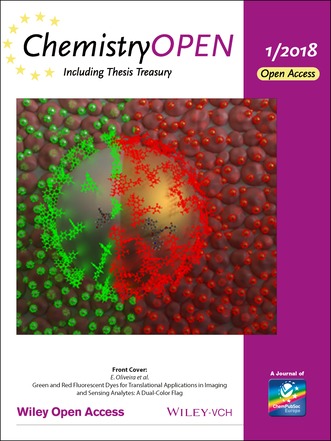Abstract
Invited for this month's cover picture is the BIOSCOPE group of Professors Carlos Lodeiro and José Luis Capelo at the REQUIMTE/UCIBIO‐LAQv‐FCT University NOVA of Lisbon (Portugal), and their collaborators. The cover picture is devoted to Translational Research, and shows the Portuguese Flag represented by the interaction between cells and Janus gold/silver nanoparticles functionalized with rhodamine (red) and Fluorescein (green) dyes as tools for biomedical translational research. Read the full text of their Review at 10.1002/open.201700135.
What prompted you to investigate this topic/problem?
 Over the last ten years, we have devoted our efforts to the design of new active functionalized nanomaterials for biomedical, environmental, and proteomics applications. All authors of the Review, members or former members of the BIOSCOPE Research Group at the FCT‐UNL, together with Prof. Emilia Bértolo from the Biomolecular Research Group at the CCUC‐UK started a collaboration on the use of functionalized nanoparticles for environmental and medical applications.
Over the last ten years, we have devoted our efforts to the design of new active functionalized nanomaterials for biomedical, environmental, and proteomics applications. All authors of the Review, members or former members of the BIOSCOPE Research Group at the FCT‐UNL, together with Prof. Emilia Bértolo from the Biomolecular Research Group at the CCUC‐UK started a collaboration on the use of functionalized nanoparticles for environmental and medical applications.
How would you describe your research?
The BIOSCOPE research group is devoted to environmental protection, proteomics, phosphoproteomics, nanoproteomics, and biomarker discovery fields using nanomaterials and selective molecules and dyes with green and red excitable units. Such smart nanomaterials can be used in biological environments, such as tissues and cells, and can be irradiated with visible light without cell damage. The ultimate goal of our research is to improve the efficacy and reduce the time‐consuming procedures of clinical diagnostics in different illnesses.
What future opportunities do you see (in the light of the results presented in this paper)?
The future aim is to design and produce new selective, sensitive, and biocompatible fluorescent probes and nanomaterials with increasingly more complex and sophisticated structures that would allow additional fine‐tuning of their properties in translational applications. Modifications to the chromophore skeleton by introducing hetero groups such as carboxylic or sulfonic acids, and carbonyl, amino, nitro, or hydroxy groups can strongly contribute to enhancing the intensity of the color and improve solubility and selectivity. On the other hand, modification the receptor unit, by changing the nature and position of the donor atoms, will be crucial to improve selectivity and sensitivity towards the target or analyte. With these systematic experimental and theoretical advances, we believe in future probes based on green and red dyes with potential applications in translational research, mainly in environment monitoring, medicine, and medical diagnosis.
Is your current research mainly driven by curiosity or rather applied?
Both! On the one hand curiosity, because it is the most powerful characteristic of a scientist and, on the other hand, it is strongly applied, as demanded by the society, contributing to the scientific progress in environmental and medical areas with new fast and efficient methodologies for target detection and quantification, as well as in the development of new smart and selective nano@materials.

Acknowledgements
The authors thank PROTEOMASS Scientific Society (Portugal), LAQV/REQUIMTE (UID/QUI/50006/2013) and UCIBIO/REQUIMTE (UID/Multi/04378/2013) for funding. H.M.S. is funded by the FCT 2015 Investigator Program (IF/00007/2015). E.O. and J.L.F. are grateful for the post‐doctoral grants SFRH/BPD/108660/2015 and SFRH/BPD/93982/2013, respectively. A.F.L. thanks the doctoral grant SFRH/BD/52528/2014 from (FCT‐MEC‐Portugal). J.D thanks Proteomass Scientific Society and FCT Project PTDC/QEQMED/2118/2014. C.N. thanks the Miguel Servet Program (CP16/00139), Instituto de Salud Carlos III, Ministerio de Economía, Industria y Competitividad (Spain). V.P. thanks the project APQ‐00360‐14 FAPEMIG‐Brazil. E.O. thanks Foundation L'Oreal (UNESCO and FCT) for the Prize For Women in Science 2015, “Medalhas de Honra L'Oréal Portugal para as Mulheres na Ciência”, healthy Sciences area. All authors thanks FCT‐MEC by the research grant PTDC/QEQ‐MED/2118/2014 in onco‐nanomaterials.
E. Oliveira, E. Bértolo, C. Núñez, V. Pilla, H. M. Santos, J. Fernández-Lodeiro, A. Fernández-Lodeiro, J. Djafari, J. L. Capelo, C. Lodeiro, ChemistryOpen 2018, 7, 3.


